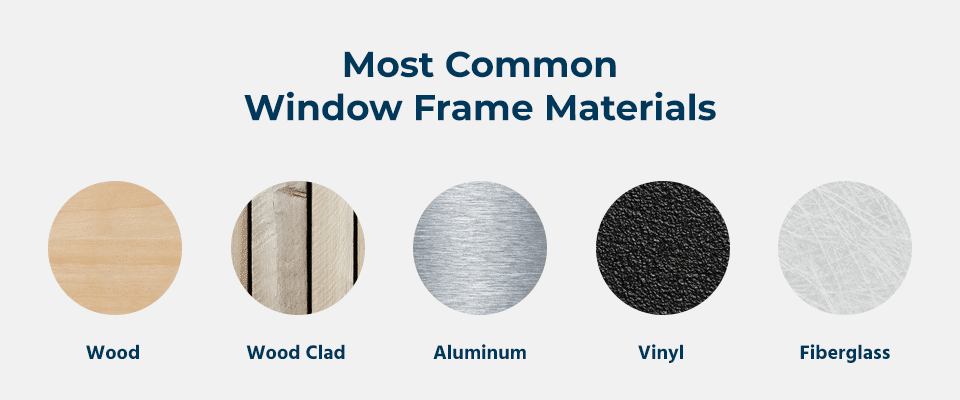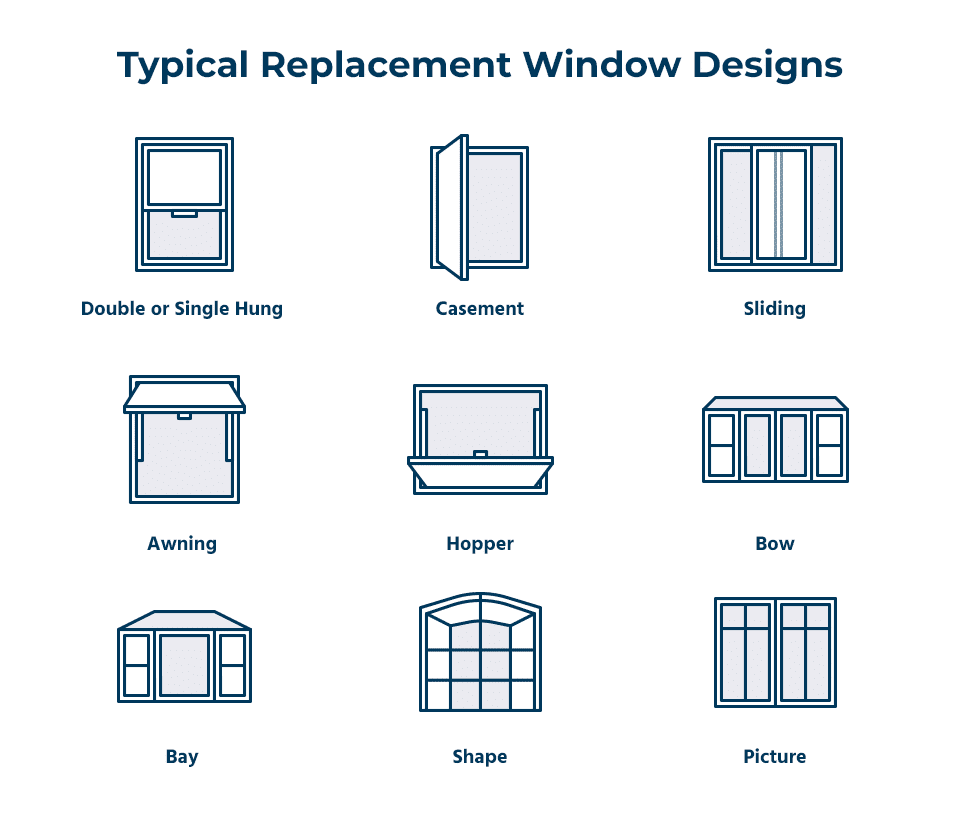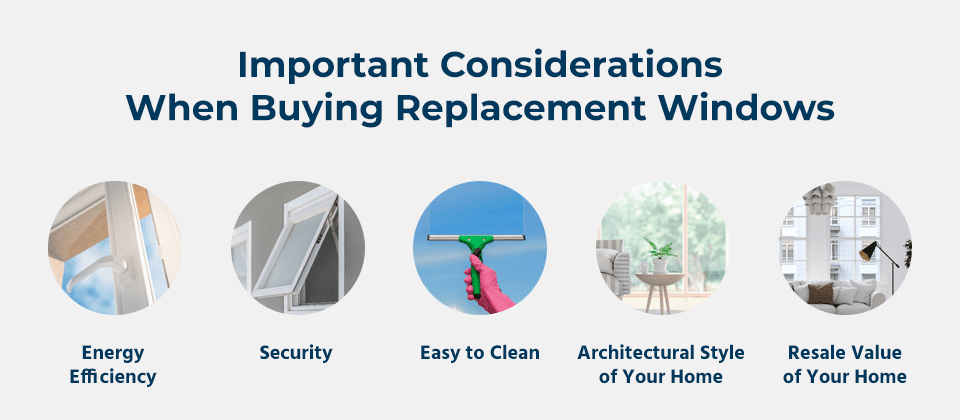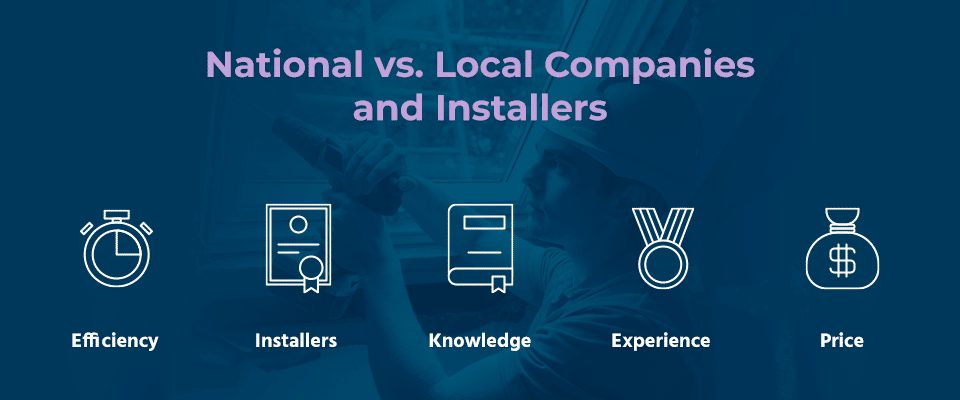When it comes to the features of a home, windows are among the most important.
Homes equipped with good windows are safe, secure and comfortable for the occupants. By contrast, homes with poor windows are vulnerable to break-ins, less energy efficient and are less comfortable for inhabitants. Not to mention a house with “good” windows can quickly deteriorate if the windows are not built to last.
If the time has come to get new windows for your home, read the following replacement window information guide for tips on how to make the right purchase.
Most Common Window Frame Materials
Frames are typically made from one of several different types of materials. The most common include:

1. Wood
Wood has been used to frame windows for centuries. From an aesthetic standpoint, the most time-honored material for window frames is wood. As a natural product, wood has a timeless appeal that can match virtually any interior scheme.
Frames made from wood provide solid insulation quality, as you can trap more warm air inside during winter months and block humid air from seeping in during summertime. This allows you to save on your heating and cooling costs during the cold and hot parts of the year.
If there is one drawback to wood window frames, it’s the amount of maintenance required to preserve the wood’s natural texture and functionality as a frame. On older frames, the wood can often become warped from repeated exposure to moisture. Real wood is also vulnerable to mites. As these factors wear away at the quality of wood frames, windows become less energy efficient and less secure.
2. Wood Clad
Wood-clad frames work against these issues because the wood is coated with protective layers of vinyl or aluminum, which are impervious to moisture, mites and the elements. With wood clad frames, you have the beautiful appearance of wood — and less of wood’s vulnerabilities.
However, wood-clad frames can still have drawbacks. In addition to the higher cost, they can rot if moisture enters along unsealed edges. The development of rot, mold and mildew can be compounded if saturated wood-clad frames expand and contract due to changes in temperature.
3. Aluminum
Aluminum is a lightweight, durable metal with natural oxides that resist the formation of rust. As such, aluminum window frames withstand the impacts of moisture. The strength of aluminum makes the material impervious to the effects of weather. Aluminum windows are not vulnerable to mites.
Depending on your local climate, you might need to rely more heavily on your HVAC system if you opt for aluminum window frames. Unlike wood window frames, Aluminum frames do not offer much insulation, and you will need to add either plastic or foam materials to act as thermal separation.
4. Vinyl
In recent decades, vinyl has grown in popularity as a window framing option. Vinyl is a material that is less susceptible to changes in weather. As a material, it doesn’t break down as easily from strong sun or bitter cold, and it won’t need painting. Vinyl will not attract mites or warp from exposure to moisture. Vinyl can also provide good insulation quality, as long as the frames contain insulating materials.
If you live in a modern home, white vinyl could easily match your scheme. If you live in an older home with classic architecture, wood-grain patterned vinyl would likely be a fitting complementary choice.
5. Fiberglass Composite
One of the most contemporary window-framing materials for today’s homes is fiberglass, which has a high quality with easy-to-clean maintenance. Fiberglass does not give into the elements or attract mites. Moreover, fiberglass does not warp or rust due to moisture.
Fiberglass offers diverse aesthetic options, as you can make the material look like almost anything. Fiberglass frames have been manufactured to mimic the appearances of both wood and vinyl.
Typical Replacement Window Designs
Most homes feature several different window designs throughout. Those designs often include:

1. Double or Single Hung
When it comes to the vertical-window opening, the most basic option is the single-hung window design. On a single-hung window, you have one upper and one lower sash. The lower sash slides up from the inside and rests in front of the upper sash, while the upper sash is immobile.
The more complex and common option is the double-hung window, which also consists of an upper and lower sash. The difference here is that both sashes can move. You can raise the bottom sash or lower the top sash.
Double-hung windows offer better air circulation, which can help make your living quarters more comfortable during warmer months. Double-hung windows also offer better safety for children and animals who could fall out of the window if the bottom sash is left open.
2. Casement
Perhaps the simplest of all window options are casement, in which the inner-frame is hinged to the outer along one side. On the other side, the window opens inward like a cabinet door. A casement window is a convenient option for homeowners who do not enjoy the task or cannot physically raise or lower single-hung or double-hung windows.
Casement windows come in several different styles. You can get single-pane versions, which consists of one long pane of glass with no cross frames. Or you can opt for double panes, on which two panes of glass are divided along the center. The third option is a casement bay window.
3. Sliding
One of the more practical options is the sliding window, which consists of two tall lites, one of which slides from side to side. When you wish to open a sliding window, you push one lite over to the other side, in front of the second lite. Most sliding windows operate a lot like a screen door.
4. Awning
In homes and apartments with more elaborate designs, you will often see window awnings. An awning is a rectangular window consisting of a single sash, which is hinged along the upper frame. To open an awning, you raise the bottom upward and inward.
Awnings are often placed above more conventional single-hung and double-hung windows in living rooms with high ceilings. In some houses, awnings are placed above front doors as well as in kitchens and bathrooms. When combined with hung or sliding windows, awnings provide excellent air circulation during warmer months.
5. Hopper
Another elegant option for homeowners is the hopper window, which is engineered as an awning with bottom hinges. A hopper will generally consist of a single rectangular sash that opens inward along the top. When open, the hopper will tilt to a 45° angle.
Like awnings, hopper windows are most often seen in more expensive homes and condominiums with high-ceiling interiors. In combination with an open hung or sliding lower window, an open hopper can stimulate the air circulation inside of a house during summer months.
6. Bow
The most complex of window assemblies is the bow window, which consists of four or more lites. A bow window composed of four lites will protrude from an outside wall like a half-octagon, with two angled outer lites and two straight inner lites. The lites might consist of single panes or be split with horizontal or vertical muntins.
In addition to the aesthetic appeal, one of the most significant advantages of bow windows is the extra space they add to a home’s interior. The inner counter of a bow window can be used to display plants, candles or other household decor. Bow windows are often seen on high-end coastal and hillside homes.
7. Bay
Bay windows are similar to bow windows, but simpler in that bay assemblies consist of only three lites. The side lites will usually open at angles while the center lite remains stationary. From the outside of a home, a bay window protrudes like a half-hexagon. Bay windows have long been a fixture of upscale homes.
As with bow windows, bay windows add space to the interior of a room. The inner counter of a bay window is a terrific place to set up flowers or other living-room decor.
8. Shape
Shape windows consist of a single lite that — true to its name — can be purchased in a variety of shapes, including domes and triangles. Shape windows are often placed above regular hung and sliding windows for extra natural light in the daytime. In some homes, shape windows are seen above doorways or by themselves as a decorative feature.
In homes and condominiums with high-ceiling staircases, shape windows are sometimes placed high above headway to provide extra light.
9. Picture
Picture windows are stationary windows that are placed on walls for the simple purpose of providing extra natural light. Consisting of a single, non-opening pane, picture windows are usually assembled with frames that are similar to those used for pictures. Picture windows are generally designated for the same spots as shape windows, such as above doorways and sliding or hung-window assemblies.
Important Considerations When Buying Replacement Windows
While material and design play a role in your decision, you also want to consider the following factors of the replacement windows:

1. Energy Efficiency
One of the most important things to consider about your choice in replacement windows is their insulation factor, especially if you live in a region where the temperature fluctuates.
As the months of fall and winter linger, the amount you spend on heating and cooling could add up to four-figures annually. When you buy new windows with superior insulating qualities, the investment could eventually pay itself back through energy savings.
Studies have shown that single-pane windows are responsible for the highest amount of insulation loss in residential homes. If you replace single-panes with ENERGY STAR®-rated window assemblies, you could save $101–$583 in annual heating costs.
2. Security
Another window-buying factor that should be a top priority among homeowners is security. When an intruder targets a home, a window will often be chosen as the point of entry. If a window is weak, a break-in is made easier for an experienced trespasser.
That is why you need to protect your house with the most durable window assemblies and best-rated windows available.
3. Easy to Clean
The easier a window is to clean, the more likely people are to maintain them.
The easiest windows to clean are those made of fiberglass composite, which won’t corrode or absorb moisture. The sleekness of composite makes it easy to clean with a single wipe. Dust, dirt and other elements will not stick to a composite surface.
4. Architectural Style of Your Home
When you shop around for new windows, it is wise to consider how a prospective choice will fit the architecture and design of your home. For example, if you live in a home that was built more than a century ago, it would be best to choose windows that work with the design style of that era. Likewise, modern window designs will easily complement most homes built within the last 30 years.
5. Resale Value of Your Home
A new set of windows can easily boost the resale value of a home by five to 10 percent. If the windows are ENERGY STAR® rated, that could be one of the selling points when the house is placed on the resale market.
Today’s discerning homeowner wants more than just a pretty house with spacious interiors. More than ever, people are concerned about energy efficiency and home security. A house equipped with strong, insulating windows is certain to attract more interest from prospective homebuyers.

1. Efficiency
Replacement windows are only worth the cost if they offer energy efficiency and security. As such, it is crucial to purchase the best possible windows.
When you invest in a good set of windows, you are investing in the comfort and security of your household and all of its belongings. Some of the best-rated windows on the market can help you boost energy efficiency by up to 54%.
Because our windows are manufactured locally, they’re better-suited to the region’s fluctuating climate. Windows designed to function in a warmer climate without the extreme temperature variations we experience in our area wouldn’t necessarily stand up as well to our blistering PA winters or scorching summers.
2. Installers
It is best to have windows installed by licensed professionals. Though it might be tempting to go the do-it-yourself route, there are numerous mistakes that an inexperienced homeowner is liable to make when attempting to self-install.
For example, the windows could be improperly placed or poorly aligned. For a set of windows to provide maximum insulation, they must be perfectly set and secured into place. A licensed, professional window installer will know how to set the windows snugly and securely into the walls of your home.
Nationally franchised companies often employ sub-contractors instead of using their own employees. We’ll always use our own team members and technicians, which means we can ensure they know our specific products inside and out as well as the best way to install them. Our employees are sure to offer the highest level of accountability and professionalism, which are highly valuable assets in both representatives and technicians.
3. Knowledge
When you go about buying replacement windows, it is essential to speak with a sales representative who will help you find windows that will fit the dimensions and complement the architecture of your home. Any company that offers the best-rated windows will share their knowledge and answer all of your questions.
Because we are a local company, we’re able to focus specifically on the climate unique to Central PA, Philadelphia and the surrounding region. We know what materials are best to keep your home as energy efficient as possible throughout all seasons. We can also tell you accurate information about our products at any time.
4. Experience
As you look through a window buying guide, it is always best to have representatives on-hand with the expertise to help you select the right windows for your house. A window seller that has been in business for many years will have the experience necessary to expertly match you with windows that can make your house more comfortable, safe, secure and aesthetically pleasing.
We know what people in this region love, and we’ve seen the aesthetic evolution of homes and windows in the area, meaning we can help you decide on the best features and details.
5. Price
The cost of a new set of windows is a small price to pay when you consider the enhanced energy efficiency and security that comes with them. With a safer and more comfortable house, you and everyone in your home can enjoy an improved peace of mind.
Moreover, the amount you are likely to save on heating and cooling can eventually pay back the cost of a new set of windows. In fact, some of the best-rated windows can save consumers up to 35% on energy bills.
You can enjoy additional cost savings by working with us at Homespire Windows because you’ll get our products directly. We cut out the middle-men often associated with national companies, which means we have solutions for all budgets and can cut down on any potential instances of miscommunication.
Buying replacement windows is one of the most important things that you can do for your home. In and around the Central Pennsylvania and Philadelphia areas, Homespire Windows and Doors offers the best-rated windows for homes. With over 25 years of home-improvement experience, our representatives can help you select the right windows for your house. Contact us today to request a free window analysis.
Get 20% Off
PLUS
No Deposit, No Payments, and No Interest for 12 Months*
*By completing the form, I consent to have Homespire Windows and its affiliates contact me to verify my information, schedule an appointment, or inform me of future product updates, which may include marketing. I consent to receive calls or texts that use automated technology or a pre-recorded voice at the phone number(s) provided. Consent is not required to receive goods and services. I can call the phone number found at the top of this web page. Please see our Terms & Conditions. Msg & data rates may apply.
